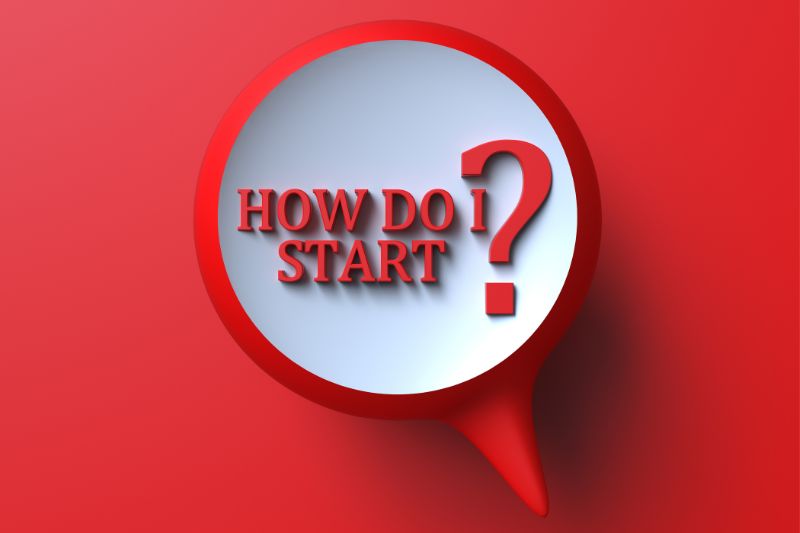Once you’re clear on why you want to learn a new language and realistic about what it takes, you’re ready to think about how to get started.
Choose Your Starting Focus
If you have a general interest in the language or live in a country where this language is spoken and want to communicate with others better, make a list of speaking needs and keep adding to it. It’s worth starting with some survival vocabulary.
If you have a partner or family member who’s a native speaker of the language and you want to communicate with them better, recruit a family member willing and able to help.
Start with useful repeated routines such as greetings and talking around daily repeated activities, like getting a meal ready or talking about what happened during the day.
If you’re traveling and you want to be able to speak some of the language there, you only need a small vocabulary.
Learn survival terms, and aim for a high degree of spoken fluency with the items in that very limited vocabulary. Put all the survival vocabulary onto word cards.

If the language is related to work or a subject you’re studying, your focus will be reading.
Begin working with texts that are relevant. This is because the technical words in the subject area make up a very large proportion of the words in such texts (somewhere between 20% and 30%; that is, one in every three to five words will be a technical word).
If the language is required for a degree, start with texts that’ll be used in your studies.
Put unknown words onto word cards, and do the same with repeated phrases. Study these cards every day. Get examples of the final exam and prepare for the kinds of questions the exam asks.
If the language is required for business purposes, start working with conversational spoken language and then move to business-focused conversation.
Once you have your starting focus, it’s time to plunge in.
Begin: Some Ideas to Get You Started

When a learner first begins learning the language, he or she should obtain a short list of survival vocabulary and phrases and memorize it. We’ll go into more detail about this in a minute.
This initial memorization will only provide a shallow knowledge and command of the language, but it’s an important first step in the language learning journey.
Memorization may be achieved through several of the 20+ language learning activities described in the Five Factor Framework, which we’ll discuss soon.
Learn useful phrases and sentences as whole units, but also understand their components and how they fit together. Understanding the parts makes the entire phrase or sentence easier to remember and apply in different contexts.
Over time, knowledge and command of the survival vocabulary and phrases can be deepened and strengthened through many of the other language learning activities described in this post.
Other tools are available to help students learn as well. They can watch a foreign language film while studying its script. Get a short course in the foreign language and begin practicing with a dictionary. A simple course is preferable.
A good place to start is to use one of the courses that native-speaking children are taught to read in school. After reading the course materials carefully, read them at least twice more quickly. Put the repeated words onto flashcards to study.
Learners are also well-advised to try to meet with a native speaker on a regular basis, either in person or online. Practice useful role plays of common situations, such as greeting and saying goodbye, shopping, asking for help, or getting directions.
Repeat these role plays several times until they can be recited confidently. Make a list of them so they can be practiced and varied over the course of several weeks.
Spend some time each week studying and practicing pronunciation, preferably with a teacher who understands the language’s sounds and nuances.
This is especially important if the language is a tone language, such as Chinese, as it’ll most likely use sounds that are very different from the learner’s first language.
Learn Survival Vocabulary: How Many Words Do I Need?

If we do a frequency count of words in a text, no matter how long that text is, we get the same pattern of results.
A small number of words are very frequent, and many words are very infrequent. Still, a rather small number of words are very frequent.
There’s good news here!
With around 120 words and phrases (which would take a total of four hours of deliberate study to learn), the student can deal with the most basic requirements:
- Meeting and greeting people
- Being polite (please, thank you)
- Going shopping
- Ordering food
- Seeking directions
- Reading signs
- Finding somewhere to stay
- Talking about oneself
- Controlling language input
This survival vocabulary is available in over 20 different languages. It’s very similar to the word and phrase lists that can be found at the back of tourist guide courses, except that this one has been well-researched.
Similar lists can also be found on the OptiLingo website. It’s a good idea very early in one’s language study to make sure that they have covered all the survival vocabulary because this is made up of very useful language items.
The ten most frequent words of English typically cover 25% of the words in any text; the 100 most frequent words cover around 50% of the text. Have a look at a page and see how often the word “the” occurs (It occurs in almost every line in this paragraph!).

By itself, that word covers 7% of any written English text. The most frequent 1,000 words cover around 80% of the words in most texts. In some languages, the coverage figures are even higher than this.
Given these trends, it’s good to learn the high-frequency words first. The effort of learning these words is rewarded by opportunities to meet and use these words.
Vocabulary specialists typically see the high-frequency words of English as consisting of around 2,000 to 3,000 words. Only a small number of these words are function words (words like the, a, of, because, it, one, which, and that). Most are nouns, verbs, adjectives, and adverbs (content words).
A large number of words are very infrequent. Half of the words in any text will occur only once in that text.
So, in a novel that is 100,000 words long from beginning to end, a reader will meet around 5,000 different words (For example, Captain Blood is 115,879 words long and contains 5,071 different word families).
Half of the unique words encountered (numbering well over 2,000) will occur only once. That means there won’t be repeated opportunities to meet these words to assist learning.
Therefore, one of the skills in learning a language is to know what words are worth learning at each stage of proficiency development.
Because there are many low-frequency words, it’s best to read material that uses a controlled vocabulary so that substantial time isn’t spent on low-frequency words that aren’t useful at the present level of proficiency.
Develop an Ear for Your Target Language

Human language is a funny thing. Take this simple sentence, for example:
“This is my thumb. I point it at them.”
Why do the unique set of sounds that make up that sentence need to be written using those letters?
Why is it that the sound “th” requires two letters? Why does the letter combination of “oi” in point make the sound it does?
Even more curiously, why do we have two “th” sounds in English, with no single letter for either of them, and a double-letter combination to represent both?
Confused?
Stick out your thumb. Now say the word thumb.
Point it at an imaginary “them.” Now say them.
Notice the difference? The “th” in thumb is hard and clean. The “th” in them is softer, and almost has a rolling “zh” sound in it. You might notice that your mouth moves in different ways to produce each of those sounds.
Why is it that we say the word “button” as “bu’on”? What about the word “cupboard”? Why do we spell it one way and pronounce it as “cubberd”?
Putting spelling aside for a moment, the reason all the statements above make sense to you is because you have “an ear” for the English language.
But if you’ve ever tried to learn a new language, you have inevitably run into difficulty picking apart where one word ends and another begins. Even for native speakers of the English language, this can be a challenge.
Take this example below:
“Excuse me while I kiss this guy.”
“Excuse me while I kiss the sky.”
The latter is a famous music lyric from Jimi Hendrix. The former is how about half the U.S. population hears that line. In fact, for a lot of native speakers of English, reading music lyrics is necessary in order to pick apart the unique sounds they’re hearing.
And if that’s the case when native speakers are engaging in their own languages, why should it be any different when learning a new language?
It’s not.
So if you’ve ever struggled to develop an ear for a new language, don’t worry. You’re not alone, and the challenge isn’t even unique to learners of a new language. It’s common among native speakers of their own languages as well.
How Do I Develop an Ear?

How do you go about developing an ear for a new language you’re learning?
The key is to get immediate feedback and understand exactly what you are hearing and what each sound is. Parents do this with small children all the time.
For example:
Parent: Do you want a banana?
Child: Aa-na-nuh!
Parent: Ba-na-na?
Child: Banana!
Through slow, steady practice, parents help small children refine their pronunciation by developing an ear for the language. This is most often done by over-enunciating unique sounds so they’re more widely contrasted from other sounds.
This is great if you’re a child. You have all the time in the world, and you have a loving, nurturing teacher guiding you through every waking moment of your life.
Very few adult language learners have this luxury, but there are a number of ways to accomplish a similar result.
If you think about why the above method works, it’s because children are given immediate feedback, followed by a process of explanation so individual sounds can be picked out at a granular level.
There are a number of language-learning apps starting to do this. In some cases, there’s a visualization that shows the sound pattern of a native speaker contrasted with your own sound pattern.
In other cases, there’s some kind of score that shows how close to or far away you are from the native speaker’s pronunciation.
I’m a bit skeptical of both approaches, as they don’t work very well for me. I’ve never really felt comfortable modulating my voice in order to match a sound wave visualization.
I’ve never comprehended how a number can help me realize whether I heard and repeated a sound properly. That said, if these systems work for you, then, by all means, keep using them.
Start with the Alphabet

But what method do I use, then? And what strategy is available to the language learner using an approach that doesn’t employ the technology described above?
For my own part, whenever I am diving into a new language or teaching someone a language I already speak, I spend a fair amount of time on the alphabet, with a real focus on vowels.
There are very few alphabets that perfectly replicate all the sounds in a given language.
Anyone who has studied French knows there are many silent letters. Even in English, as I demonstrated at the top of this section, there are two “th” sounds, and the alphabet lacks a single letter to reflect either of them.
Still, we have to start somewhere, and the alphabet is a great place. Why do I spend so much time on vowels?
It’s been my personal experience that consonants are more stable across human languages than vowel combinations. I don’t have any science or statistics handy to back up my claim, but that’s my opinion.

At the same time, vowels and combinations of vowels (sometimes referred to as “diphthongs”) can be a bit more unique and exotic.
Take the Russian vowel “ы”, which is found in the formal word for “you” – Вы.
This letter sounds a bit like the sequence of vowels found in the French word for “yes” – oui.
Of course, while it’s close, it’s not exact, and lots of Russian students have a hard time learning to make this sound perfectly.
Even then, many Russian students have a hard time parsing all the unique vowel combinations that stem from Russian vowel endings.
For example:
faster: быстрее (buistryeye); hers: её (yey-yo); beautiful: прекрасный (prekrasnuiyee)
Those are Russian words in the examples above, but the challenge applies to any language you might be learning, especially if you’re just starting out.
So once I get a solid grasp of the alphabet, I make deliberate efforts to read my study materials while listening to proper pronunciation of what I am reading. This works well if you have study materials that include audio files to go along with written content.
Use Google Translate or similar technologies if you’re in a pinch. The pronunciation might not always be perfect, but it’s better than nothing and getting better all the time.
What tends to work for me is a combination of reading silently and reading out loud. Then I’ll listen to an audio file without reading. Then I’ll listen to the audio file while reading, and try it again on my own.
This approach provides many of the benefits that children get when they’re learning a language.
By listening to audio while reading the written text, you’re able to receive immediate feedback on where sounds start and end, and how they tie into the unique sequence of letters you’re learning.
Just Don’t Give Up

Learning to sing on pitch, play an instrument, knit a pair of socks, tie a knot, and hundreds of other skills requires us to develop a feel for the skill we’re developing. Whether it’s words or yarn, it takes time.
We tend to put time into activities we like, so find combinations of language learning activities you enjoy, and don’t worry.
You’ll develop your ear for your language naturally. Probably without noticing, your comprehension of the spoken word will sharpen, and your pronunciation will follow… just as it did when you were a toddler learning your first language – English.







